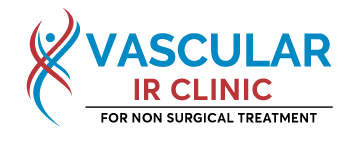Varicose veins are dilated tortuous veins filled with blood that appear just under your skin’s surface in your legs. When your vein valves become weak and unable to function cause the retension and reverse flow of blood leading to pooling of blood in the legs. Causing the blue bulges on your legs, feet or ankles.
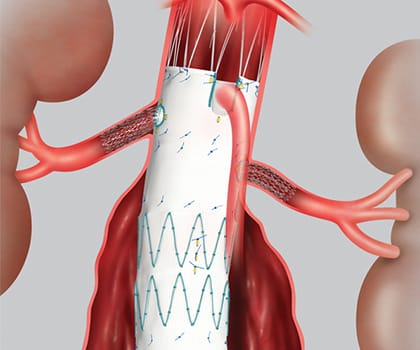
What are varicose veins?
They are dilated tortuous veins that can be painful or itchy. Spider veinsare smaller red or purple lines that appear on the skin surface.
In some cases, more than the dull aching pain these varicose veins can lead to swelling, burning sensation in the foot, muscle cramps, pigmentation, itching, heaviness, tightness and weakness in the legs. You can relieve most varicose vein symptoms with injections, laser therapy or glue treatment.
What is the difference between varicose veins and spider veins?
Spider veins aren’t usually painful. They can appear anywhere on your body, most often behind your knee, on your feet or on your face. Varicose veins usually appear on your feet and legs.
Who is likely to get varicose veins?
Anyone can develop varicose veins. Certain factors increase your chances of developing varicose veins, including:
Book An Appointment
- Long-standing: any profession which involves longstanding as in teachers, and traffic police most affected
- Sedentary lifestyle: as in IT professionals, bankers are most affected due to sedentary lifestyle
- Post-pregnancy: women develop varicosities during pregnancy and post-pregnancy they increase in severity.
- Obesity: weight is the major cause of concern.
- Gender:Female hormones can allow the walls of the veins to stretch.
- Family history: This condition can be inherited
- Age: Because of the aging process, Veins lose elasticity and stiffen.
How common are varicose veins?
Varicose veins are very common. Around 1/3 of all adults have varicose veins, right from 20years of age.
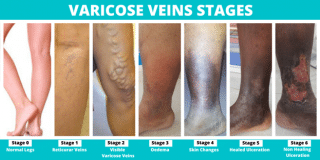
- Dilated, tortuous, twisted veins: They appear just below the surface of the skin on your legs, ankles, and feet.
- Heavy legs: Muscles in your legs may feel tired, heavy, or sluggish, especially after physical activity.
- Itching: The area around varicose veins may itch.
- Pain: Legs may be painful, achy or sore, especially behind your knees. You might have muscle cramps.
- Swelling: Your legs, ankles and feet can swell and throb.
- Skin discolorations and ulcers: If left untreated, varicose veins can cause bluish / black discolorations on your skin.
- Non healing ulcers: Severe varicose veins can cause venous ulcers (sores) on your skin.
- Burning sensation in the foot and Skin dryness
Where do varicose veins usually appear on the lower half of your body, usually on your calves, ankles and feet. They can also develop in the pelvic area (pelvic congestion syndrome), especially in people who have had children. Varicose veins in the testicles (varicocele) can lead to infertility.
Complications if left untreated:
- Non-healing ulcers
- Bleeding
- DVT
- Are some of the serious complications
Varicose veins occur when the walls and valves of your veins weaken. As blood pressure in your vein increases, the weakened walls allow your vein to get bigger. And due to weakness of valves the blood in vessels is reversed or stagnation and pooling of blood happens leading to dilated vessels.
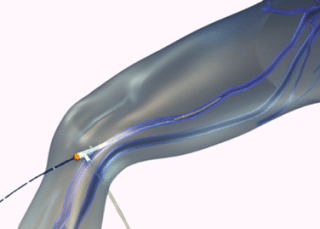
How are varicose veins diagnosed?
Varicose veins are close to the surface of your skin and easy to see and can diagnose the condition during a physical examination.
Ultrasound: This safe, painless test shows blood clots and how your valves are working.
What is the treatment for varicose veins?
- Injection therapy (sclerotherapy): During sclerotherapy, a solution is injected into your veincausing the vein walls to stick together. Eventually, your vein turns into scar tissue and fades away.
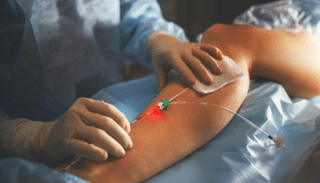
- Laser therapy: In a minimally invasive procedure called endovenous thermal ablation, (EVLT) healthcare providers use a catheter (a long, thin tube) and laser to close off a damaged vein.
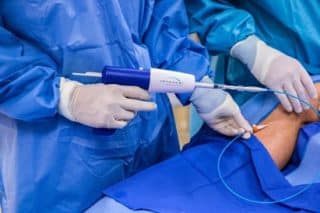
- GLUE TREATMENT : THIS IS THE MOST ADVANCED AND EFFECTIVE MODE OF LASER TREATMENT WHICH IS COMPLETELY PAIN FREE AND PATIENT CAN WALK HOME JUST WITH IN FEW HOURS AFTER GLUE TREATMENT.
ALL THE ABOVE PROCEDURES ARE NON-SURGICAL WHICH INVOLVES NO CUTTING, SUTURE OR SCAR. IT IS JUST AN IV CANNULA TECHNIQUE, where a cannula is placed in the ankle area and through it using usg guidance a hair thickness probe is passed into it and laser treatment is done. all through just that single pin-like hole.
post-procedure absolutely there are no signs of any surgery, in fact, you will not even know from where it is done.
POST PROCEDURE PT CAN GO BACK HOME WALKING AFTER THE OBSERVATION PERIOD AND CAN RESUME NORMAL ACTIVITIES FROM NEXT DAY.
How can I prevent varicose veins?
You may not be able to prevent varicose veins. You can reduce your chances of developing them by living an active, healthy lifestyle. Healthcare providers recommend many of the same measures to prevent and treat varicose veins:
- Avoid long periods of standing: To encourage blood flow, take regular breaks to stretch and walk around, especially if you have a job that requires you to be on your feet.
- Elevate your legs: Raising your feet above your waist helps blood flow to your heart.
- Maintain a healthy weight: Getting rid of excess pounds reduces pressure inside your blood vessels.
- Stay active: To improve circulation, move frequently and avoid sitting still for prolonged periods.
- Try compression stockings: Support socks and pantyhose compress your veins and help blood circulate, which can prevent varicose veins from getting worse.
- Non-healing ulcers (open sores),
- bleeding and
- skin discoloration
- develop blood clots
- Superficial thrombophlebitis: Thrombophlebitis is painful.
- Deep vein thrombosis (DVT): People with varicose veins have a higher risk of deep vein thrombosis.
- Pulmonary embolism: can lead to blood clot traveling to lungs. it is a life-threatening condition that requires immediate treatment.
Although treatments are very effective if done by experienced operator, varicose veins can return in non compliant pateints, and morbid obese pt, however the success percentage is more than 95-98%.
You should see your provider as soon as possible if the skin or veins are:
- Bleeding.
- Discolored.
- Painful, red or warm to the touch.
- Swollen.
- VEIN SURGERY / SURGICAL STRIPPING :
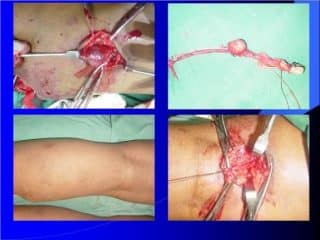
- During these procedures, also called ligation and stripping, the surgeon ties off your affected vein (ligation) to stop blood from pooling. The surgeon may remove (strip) the vein to prevent varicose veins from reappearing.This more of a surgery where it involves surgical cutting and opening. Basically it’s a procedure done and practised 10-15years back.now its almost outdated.
Q: HOW SUCCESSFUL IS LASER / GLUE TREATMENT?
A: These r the most advanced and highly successful treatment options preferred world over, when done by well-trained and experienced vascular intervention radiologists.
Q: Who does laser/glue treatment?
A: Vascular interventional radiologist usually dones the procedures preferably as he has good understanding of Doppler imaging. Imaging is the key to the success of the treatment.
Q: Is varicose veins laser/glue treatment the permanent solution?
A: Yes, this is the successful non-surgical treatment with almost no recurrence if post-procedure instructions are strictly followed.
Q: When can I go back to my routine activities?
A: Can resume normal activities from the next day and can go back to work after 2 days.Any restriction of activities or food post procedure/Absolutely no restriction of any activity or food.
Q: Can I climb stairs / RIDE BIKE. Post procedure?
A:Yes, absolutly after 2nad all activities can be resumed.
